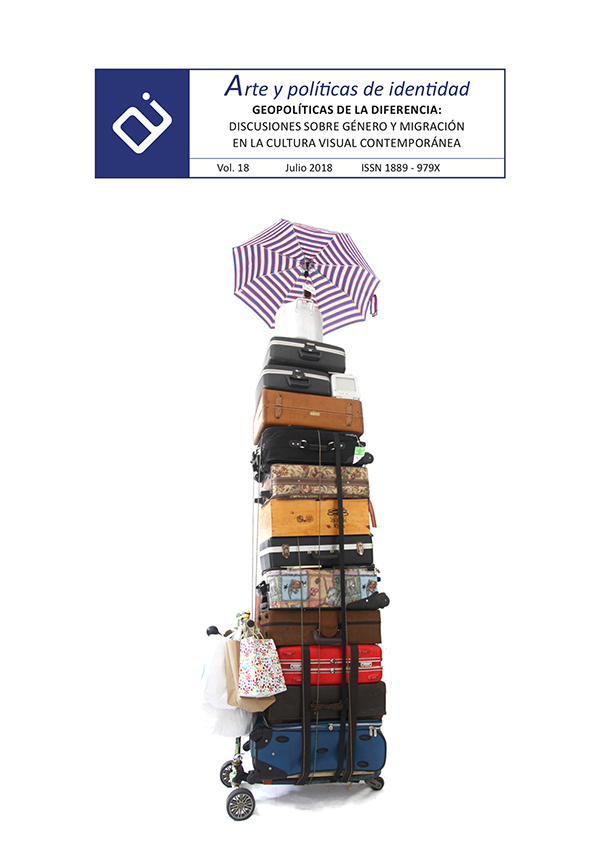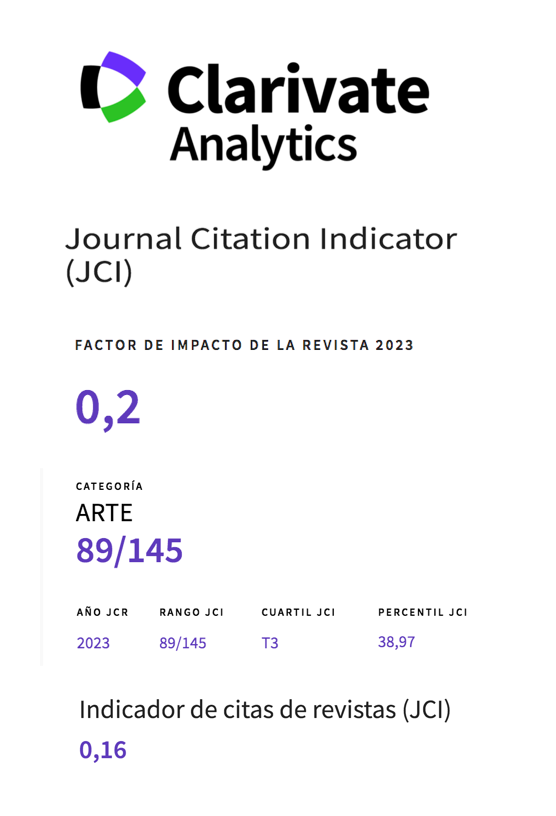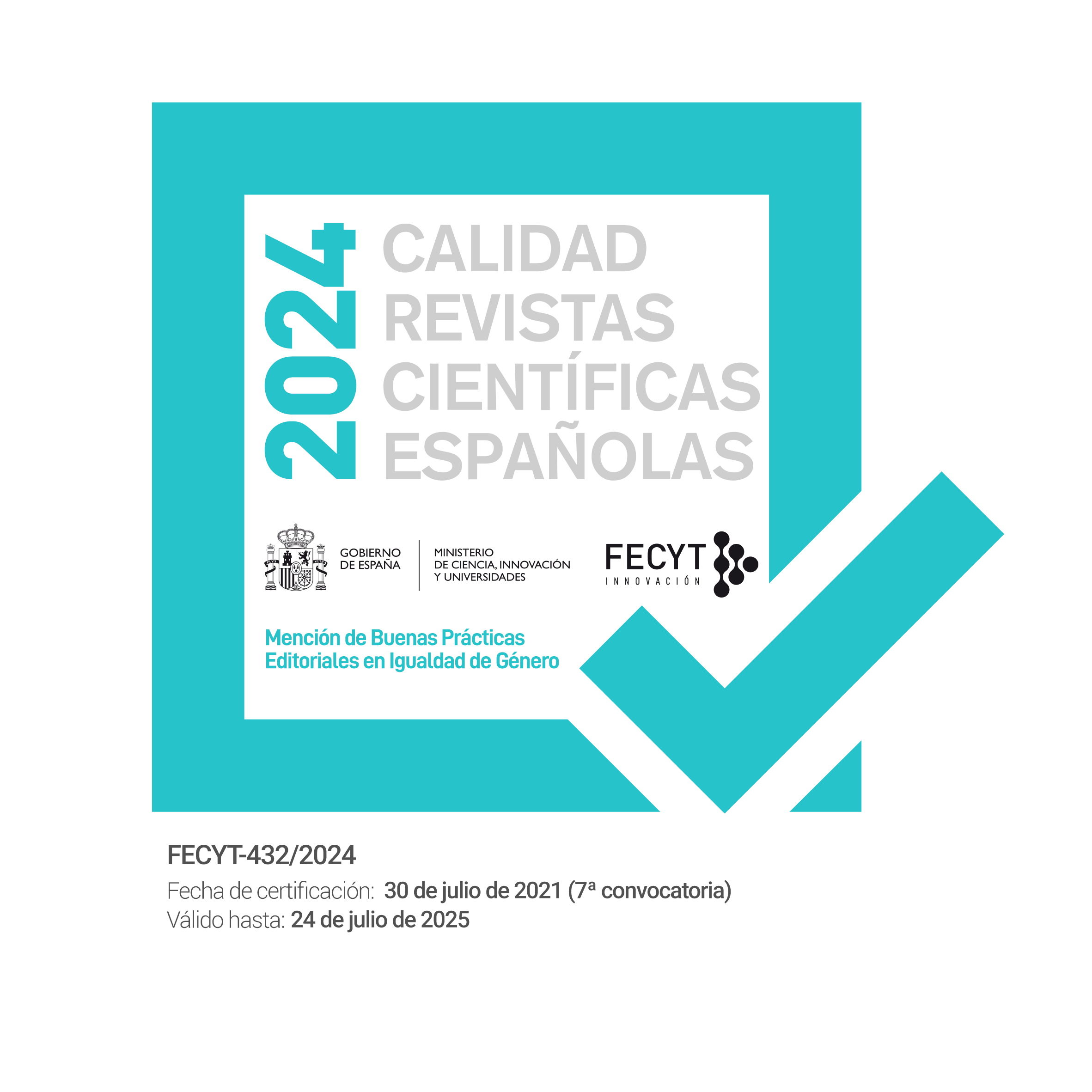Media Aesthetics
Two Examples in the Spanish Art
Resumen
This article unveils an aesthetic based on the intervention of machinery into creative art procedures. The study goes deeply into a machine-related aesthetic from philosophic reflections, which range from the incursions of, firstly, optical technologies (photography, cinematography) and then electronic technologies (videograph, computer graphics, networks). The research throws new light on the notion of Media Art. The media have opened up to artists the possibilities of the laboratory for aesthetic experimentation and the innovative inter-relationship of art, science, and technology.
In this sense, the text demonstrates how new media creativity experiments with forms more representative of postmodern thinking. For the purposes of a better exemplification of the question raised, this article has briefly analysed the works of two Spanish artists, representative of the two different phases. The first example opens with the commencement of an incipient Media Art in the technological and mystical ruminations of José Val del Omar. In the second example, the contemporary evolution into internet experimentation of Antoni Muntadas is demonstrated.
Descargas
-
Resumen392
-
PDF339
Citas
Anderson, Perry. (2005). As origens da Pós-Modernidade. Lisboa: Edições 70.
Aracil, Alfredo. (1998). Juego y artificio: Autómatas y otras ficciones en la cultura del Renacimiento a la Ilustración. Madrid: Cátedra.
Bauman, Zygmunt. (2007). Arte ¿líquido? Madrid: Sequitur.
Bauman, Zygmunt. (2009). Modernidad líquida. Buenos Aires: Fondo de Cultura Económica.
Berenguer, Xavier., Van den Boom, Holger., Català Domènech, Josep M., Costa, Mario., Couchot, Edmond., Giannetti, Claudia., Jiménez, José., et al. (1997). Arte en la era electrónica. Perspectivas de una nueva estética. Barcelona: ACC L ́Angelot.
Boden, Margaret. (1991). The Creative Mind: Myths and Mechanisms. New York: BasicBooks.
Brown, Neil C.M., Barker Timothy S., and Del Favero, Dennis. (2011). “Performing Digital Aesthetics: The Framework for a Theory of the Formation of Interactive Narratives”, Leonardo, 44 (3): 212–219.
Connor, Steven. (2002). Cultura Postmoderna. Introducción a las teorías de la contemporaneidad. Madrid: Akal.
Contreras, Fernando R. (2012). “Una nueva relación entre el artista y su obra: La obra de arte en la era digital”, Revista TELOS (Cuadernos de Comunicación e Innovación), 10: 1-10.
Crespo Fajardo, José Luis. (2013). “Antoni Muntadas. Videocreación e instalación audiovisual”, La Colmena, 79: 43-48.
David, Benjamin, Bogart, Robert and Pasquier, Philippe. (2013). “Context Machines: A Series of Situated and Self-Organizing Artworks”, Leonardo, 46 (2): 114–122.
Dikovitskaya, Margaret. (2005). Visual Culture. The Study of the Visual after the Cultural Turn. Cambridge, London: The MIT Press.
Dubois, Philippe. (2006). Recherches sur Chris Marker. Paris: Presses Sorbonne Nouvelle.
Dumitriu, Anna., and Whitby, Blay. (2011). “Cybernetic Bacteria 2.0”, Leonardo, 44 (3): 264–265.
Faulkner, Michael., and D-Fuse. (2006). Vj. Audio-visual art and vj culture. UK: Laurence King Publishing Ltd.
Ferry, Luc. (2012). Homo Aestheticus. A inveção do gosto na era democrática. Lisboa: Edições 70.
Francastel, Pierre. (1990). Arte y técnica en los siglos XIX y XX. Madrid: Editorial Debate.
González Manrique, Manuel Jesús. (2008). Val del Omar. El moderno renacentista. Granada: Fundación Ibn al-Jatib de Estudios de Cooperación Cultural.
Guasch, Ana María. (2000). El arte último del siglo XX. Del posmodernismo a lo multicultural. Madrid: Alianza Editorial.
Gubern, Román. (2004). Val del Omar, cinemista. Granada: Diputación de Granada.
Halpern, Megan K., and Star Rogers, Hannah. (2013). “Inseparable Impulses: The Science and Aesthetics of Ernst Haeckel and Charley Harper”, Leonardo, 46 (5): 465–470.
Haraway, Donna Jeanne (1995). Ciencia, cyborgs y mujeres : la reinvención de la naturaleza. Madrid: Cátedra.
Hatfield, Jackie, ed. (2006). Experimental Film and Video. Eastleigh, UK: John Libbey Publishing.
Howells, Richard. (2008). Visual Culture. Cambridge, Malden: Polity Press.
Ilfeld, Etan J. (2012). “Contemporary Art and Cybernetics: Waves of Cybernetic Discourse within Conceptual, Video and New Media Art”, Leonardo, 45 (1): 57–63.
Jensen Hines, Thomas. (1991). Collaborative Form: Studies in the Relations of the Arts. Kent, Ohio and London, England: The Kent State University Press.
Kaipainen, Mauri., Ravaja., Niklas, Tikka, Pia., Vuori, Rasmus., Pugliese, Roberto., Rapino, Marco and Takala, Tapio. (2011). “Enactive Systems and Enactive Media: Embodied Human-Machine Coupling beyond Interfaces”, Leonardo, 44 (5): 433–438.
Kester, Grant H. (2004). Conversation Pieces: Community and Communication in Modern Art. Berkeley, Los Angeles, London: University of California Press.
Kittler, Friedrich. (1999). Gramophone, Film, Typewriter. Stanford, California: Stanford University Press.
Kittler, Friedrich. (2012a). Optical Media. Cambridge: Polity Press.
Kittler, Friedrich. (2012b). Literature, media, information systems: essays. Routledge: New York.
Kracauer, Siegfried. (1997). Theory of film. The Redemption of Physical Reality. Princeton, New Jersey: Princeton University Press.
Llobera, Joan., Blom Kristopher J., and Slater, Mel. (2013). “Telling Stories within Immersive Virtual Environments”, Leonardo, 46 (5): 471–476.
López de Mántaras Badia, Ramón. (2013). “Computational Creativity”. Arbor, 189(764): a082 doi: http://dx.doi.org/10.3989/arbor.2013.764n6005
Lucie-Smith, Edward. (2006). Os movimientos artísticos a partir de 1945. São Paulo: Martins Fontes.
Luna Delgado, D. (2015). “En torno a the file room de Antoni Muntadas: un ejemplo pionero de ciberartivismo”. En Move.Net: Actas del I Congreso Internacional Move.Net sobre Movimientos Sociales y TIC: 218-231.
Machado, Arlindo. (2000). El paisaje mediático: Sobre el desafío de las poéticas tecnológicas. Buenos Aires: Universidad de Buenos Aires.
Marchán Fiz, Simón. (2010). Del arte objetual al arte de concepto (1960-1974). Madrid: Akal.
Martín Prada, Juan. (2012). Otro tiempo para el arte. Cuestiones y comentarios sobre el arte actual. Valencia: Sendemà Editorial.
Prado, Gilbertto. (2005). “Redes y espacios artísticos de intervención”. En Estética, ciencia y tecnología. Creaciones electrónicas y numéricas, editado por Hernández García, Iliana, 172-180. Bogotá: Editorial Pontificia Universidad Javeriana.
Radio Televisión Española. “Entrevista a Antoni Muntadas”. Acceso 23 de junio de 2014. http://www.rtve.es/television/20120113/antoni-muntadas/489198.shtml
Rees, A. L. (2005). A History of Experimental Film and Video. London: British Film Institute.
Schneckenburger, Manfred., Fricke, Christiane., and Honnef, Klaus. (2005). Arte do Século XX. Vol. 2. Köln: Taschen.
Stern, Nathaniel. (2011). “The Implicit Body as Performance: Analyzing Interactive Art”, Leonardo, 44 (3): 233–238.
Utterson, Andrew. (2013). “Early Visions of Interactivity: The in (put)s and Out (put)s of Real-Time Computing”, Leonardo, 46 (1): 67–72.Val del Omar’s, José. “Otros escritos”. Acceso 30 de junio de 2014. http://www.valdelomar.com/
Weibel, Peter. (1996). “The World as Interface: Toward the Construction of Context-Controlled Event-Worlds”. In Electronic Culture: Technology and visual representation, edited by Druckrey, Timothy, 338-343. New York: Aperture.
Wu, Faye., Selvadurai, Chindhuri., Smithwick, Quinn., Cain, James., Cavallerano, Jerry., Silver, Phil and Goldring, Elizabeth. (2012). “The Seeing Machine Camera: An Artistic Tool for the Visually Challenged Conceived by a Visually Challenged Artist”, Leonardo, 45 (2): 141–147.
Yoon, Joonsung., Song, Kwanho and Kim, Insub. (2013), “Digital Mandala: The post-virtual as meditation of impermanence or a new reality”, Leonardo, 46 (5): 496–497.
Zhang, Kang., Harrell, Stuart and Ji, Xin. (2012), “Computational Aesthetics: On the Complexity of Computer-Generated Paintings”, Leonardo, 45 (3): 243–248.
Zoran, Amit and Buechley, Leah. (2013). “Hybrid Reassemblage: An Exploration of Craft, Digital Fabrication and Artifact Uniqueness”, Leonardo, 46 (1): 4–10.
Works published in this journal are subject to the following terms:
- The Service of Publications from the University of Murcia (publishing house) keeps the published works’ copyrights, and favors and allows the reuse of these works under the license indicated in point 2.
- Works are published in the journal’s online edition under the license Creative Commons Reconocimiento-NoComercial-SinObraDerivada 3.0 España(texto legal). They can be copied, used, disseminated, transmitted and publicly exhibited, as long as: i) the author and original source of publication are cited (journal, publishing house and work’s URL); ii) they are not used for commercial purposes; iii) the existence and specifications of this license are mentioned.
3. Conditions for auto-file. It is allowed and encouraged that authors share electronically their pre-print version (the pre-reviewed version) and /or post-print version (the reviewed and accepted version) of their Works before the publication, since it promotes its circulation and dissemination. RoMEO color: green.










